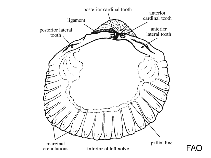Frigidocardium valdentatum Poutiers, 2006
| Native range | All suitable habitat | Point map | Year 2050 |

|
| This map was computer-generated and has not yet been reviewed. |
| Frigidocardium valdentatum AquaMaps Data sources: GBIF OBIS |
Google image | No image available for this species;
drawing shows typical species in Cardiidae.
Classification / Names Common names | Synonyms | CoL | ITIS | WoRMS
Bivalvia | Cardiida | Cardiidae
Environment: milieu / climate zone / depth range / distribution range Ecology
Benthic; depth range 82 - 460 m (Ref. 3194). Tropical
Distribution Countries | FAO areas | Ecosystems | Occurrences | Introductions
Pacific Ocean. From off New Caledonia to Fiji and Tonga Island, north to Vanuatu and south to northern Norfolk Ridge.
Length at first maturity / Size / Weight / Age
Maturity: Lm ? range ? - ? cm
Life cycle and mating behavior Maturity | Reproduction | Spawning | Eggs | Fecundity | Larvae
Main reference
References | Coordinator | Collaborators
Poutiers, J.M. 2006 Two new species of protocardiine cockles (Mollusca, Bivalvia, Cardiidae) from the tropical Southwest Pacific. Zoosystema 28(3):635-654. (Ref. 3194)
IUCN Red List Status
(Ref. 130435: Version 2025-1)
CITES status (Ref. 108899)
CMS (Ref. 116361)
Threat to humans
Human uses
| FishSource |
Tools
More information
Diet composition
Food consumption
Predators
Max. ages / sizes
Length-weight rel.
Length-length rel.
Length-frequencies
Mass conversion
Abundance
Internet sources
BHL | BOLD Systems | CISTI | DiscoverLife | FAO(Publication : search) | Fishipedia | GenBank (genome, nucleotide) | GloBI | Gomexsi | Google Books | Google Scholar | Google | PubMed | Tree of Life | Wikipedia (Go, Search) | Zoological Record



